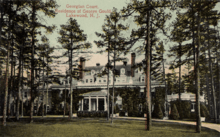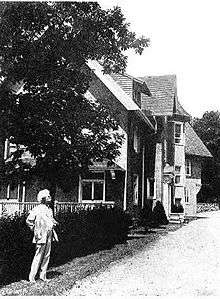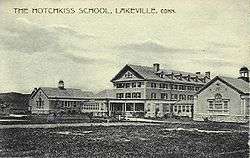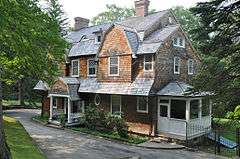Bruce Price
| Bruce Price | |
|---|---|
 | |
| Born |
December 12, 1845 Cumberland, Maryland, United States |
| Died |
May 29, 1903 (aged 57) Paris, France |
| Nationality | American |
| Alma mater | Princeton University |
| Occupation | Architect |
| Spouse(s) | Josephine Lee |
| Children | 2 |
Bruce Price (12 December 1845 – 29 May 1903) was an American architect and an innovator in the Shingle Style. The stark geometry and compact massing of his Tuxedo Park, New York cottages influenced Modernist architects, including Frank Lloyd Wright and Robert Venturi.[1]
He also designed Richardsonian Romanesque institutional buildings, Beaux-Arts mansions, and Manhattan skyscrapers. In Canada, he designed Chateauesque railroad stations and grand hotels for the Canadian Pacific Railway, including Windsor Station in Montreal and Château Frontenac in Quebec City.
Biography


Frank Lloyd Wright may have modeled his Oak Park house and studio after these two cottages.
Price was born in Cumberland, Maryland, the son of William and Marian Bruce Price. He studied for a short time at Princeton University. After four years of internship in the office of the Baltimore, Maryland architects Niernsee & Neilson (1864–68), he began his professional work in Baltimore with Ephraim Francis Baldwin as a partner.[2] Following a brief study trip to Europe, he opened an office in Wilkes-Barre, Pennsylvania, where he practiced from 1873 to 1876.
He settled in New York City in 1877, where he worked on a series of domestic projects. These culminated in the design and layout of the exclusive 7,000-acre planned community of Tuxedo Park (1885–86), created by Pierre Lorillard IV. The striking buildings Price designed there, with their severe geometry, compact massing and axial plans, were highly influential in the architectural profession. Eight of Price's houses – including five from Tuxedo Park – were among the one hundred buildings selected for George William Sheldon's landmark survey of American domestic architecture: Artistic Country-Seats (1886–87).[3] The most famous of these, the Pierre Lorillard V cottage ("Cottage G"), though demolished and now known only through photographs, remains an icon of American architecture. Price's daughter wrote in 1911:
"In beginning Tuxedo, the architect's idea was to fit buildings with the surrounding woods, and the gate-lodge and keep were built of graystone with as much moss and lichen as possible. The shingled cottages were stained with the color of the woods—russets and grays and dull reds—ugly to the taste of a quarter century later, though this treatment did much to neutralize the newness of the buildings—Old World and tradition-haunted as it looks, it is new, incredibly new."[4]
Among the Manhattan office buildings he designed were the American Surety Building, the St. James Building, the Bank of the Metropolis and the International Bank. He also collaborated with sculptor Daniel Chester French on the Richard Morris Hunt Memorial (1898) in Central Park. He designed a lecture hall and a dormitory at Yale University. His grandest residential commission was Georgian Court, the neo-Georgian estate of George Jay Gould I in Lakewood, New Jersey.
Price invented, patented, and built the parlor bay-window cars for the Pennsylvania Railroad and the Boston and Albany Railroad.[5] This work prompted the Canadian Pacific Railways to consider his portfolio. He designed the Château Frontenac in Quebec for the Canadian Pacific (arguably the structure Price is most identified with), as well as the first Banff Springs Hotel in Alberta, and many other hotels and stations.
He was a Fellow of the American Institute of Architects (1890), and belonged to the Architectural League of New York. In 1900, he entered into a partnership with French architect Jules Henri de Sibour, who had earlier worked in his office. The firm continued to use the name "Bruce Price & de Sibour" until 1908, five years after Price's death.
In 1871, Price married Josephine Lee, the daughter of a Wilkes-Barre coal baron. They had two children: Emily Price Post, who became a novelist and the American authority on etiquette; and William, who died in infancy. Price is buried, along with his wife and son, in Hollenback Cemetery in Wilkes-Barre, Pennsylvania.
Selected works
United States




- 10 East Chase Street, Baltimore, Maryland (ca. 1870).
- Coryell Apartment Building, 21 East 21st Street, Manhattan, New York (1878).[6]
- James Alfred Roosevelt Estate, Cove Neck, New York (1881).
- "Cleftstone" (Charles T. How cottage), Bar Harbor, Maine (1881). Now Cleftstone Manor Hotel.[7]
- "Seacroft", Rumson, NJ (1881)
- "Far Niente" (William B. Rice cottage), Bar Harbor, Maine (1882, demolished 1943).
- J. M. Wayne Neff residence, Cincinnati, Ohio (1882, demolished). Listed in Sheldon's Artistic Country-Seats (1886–87).
- "Seaverge" (George F. Baker residence), Monmouth Beach, New Jersey (c. 1884, demolished). Listed in Sheldon's Artistic Country-Seats (1886–87).
- Cordelia Sterling residence, Stratford, Connecticut (1886). Listed in Sheldon's Artistic Country-Seats (1886–87).
- Osborn Hall, Yale University, New Haven, Connecticut (1887–88, demolished 1926).[8]
- Welch Hall, Yale University, New Haven, Connecticut (1891).
- Main Building, Hotchkiss School, Lakeville, Connecticut (1892, demolished 1970).
- Elizabeth Train Station, Elizabeth, New Jersey (1893–94). Built as Central Railroad of New Jersey Depot.
- American Surety Building, 100 Broadway, Manhattan, New York (1894, altered). Architect Herman Lee Meader widened the building and added additional stories in 1922.
- "The Turrets" (John J. Emery house), Bar Harbor, Maine (1895). Now part of College of the Atlantic.[9]
- St. James Building, 1133 Broadway, Manhattan, New York (1896).
- "Georgian Court" (George Jay Gould mansion), Lakewood, New Jersey (1896). Now Georgian Court College.
- Richard Morris Hunt Memorial, Fifth Avenue between 70th & 71st Streets, Central Park, New York City (1898), with sculptor Daniel Chester French.
- Old Washington County Library, Hagerstown, Maryland (1900).
- Whittier Hall Dormitories, Teachers College, Columbia University, Manhattan, New York (1901), with J. M. Darragh.[10]
- Audrain Building, 220-30 Bellevue Avenue, Newport, Rhode Island (1902).
- Bank of the Metropolis, 31 Union Square West, Manhattan, New York (1902–03).
- Northfield Chateau, Northfield, Massachusetts (1903, demolished 1963).
Tuxedo Park, New York
- Tuxedo Park Post Office, Tuxedo Park (1885).
- Gate-Lodge and Keep, Tuxedo Park (1885–86).[11][12][13]
- Erie Railroad Tuxedo Park Station, Tuxedo Park (1885).[14]
- "Cottage G" (Pierre Lorillard V Cottage), Tuxedo Park (1885–86, demolished).[15] Listed in Sheldon's Artistic Country-Seats (1886–87).
- William Kent Cottage, Tuxedo Park (1885–86, demolished). Listed in Sheldon's Artistic Country-Seats (1886–87). Vincent Scully argues that Frank Lloyd Wright modeled his Oak Park house and studio after this and the Chanler cottage.[16]
- W. Chanler Cottage, Tuxedo Park (1885–86, altered).[17] Scully identifies the client as "W. Chandler," but it was likely Winthrop Astor Chanler.[18]
- The Tuxedo Club, Tuxedo Park (1886, demolished 1927).
- Pierre Lorillard IV Cottage, Tuxedo Park (1886, altered). Listed in Sheldon's Artistic Country-Seats (1886–87).
- Henry I. Barbey Cottage, Tuxedo Park (1886, demolished). Listed in Sheldon's Artistic Country-Seats (1886–87).
- Travis Van Buren Cottage, Tower Hill Road, Tuxedo Park (1886, altered beyond recognition).[19] Listed in Sheldon's Artistic Country-Seats (1886–87).
- Francis D. Carley Cottage, West Lake Road, Tuxedo Park (1886, moved from original site 1896).
- Tuxedo Park School (first building), Tuxedo Park (c. 1887, demolished).
- M. G. Barnwell Stable, Clubhouse Road, Tuxedo Park (1889–90).
- Meta K. Cruger Cottage, Tower Hill Road, Tuxedo Park (c. 1890).
- Japanese Cottage, 16 Summit Road, Tuxedo Park (1891).
- Our Lady of Mount Carmel Roman Catholic Church, Route 17, Tuxedo Park (1895, burned 1897).
- Bruce Price Cottage, Pepperidge Road, Tuxedo Park (1897).
- Voss Cottage, Pepperidge Road, Tuxedo Park (c. 1897). One of four cottages Price built for rental. Samuel Clemens rented it in 1908.
- Emily Post cottage, Tuxedo Park (c. 1897). One of four cottages Price built for rental. His daughter Emily inherited it.
- Addison Cammack House, Tuxedo Park (1900).
- Price Collier House, West Lake Road, Tuxedo Park (1900).
- Tuxedo Park Association Offices, Route 17, Tuxedo Park (1900).
- Tuxedo Stores (Business Block), Route 17, Tuxedo Park (c. 1900).
- Tuxedo Park Library, 227 Route 17, Tuxedo Park (1901).
- Methodist Episcopal Church, 7 Hospital Road, Tuxedo Park (1902). Now Tuxedo Historical Society.[20]
- R. M. Gillespie House, Tuxedo Park (1903).
Canada
- Windsor Station, Montreal, Quebec (1887–89).
- Banff Springs Hotel, Banff National Park, Alberta (1888, demolished 1925). Price's wood-and-shingle hotel was replaced by one of stone and concrete.[21]
- James Ross House, Montreal, Quebec (1892). Now Chancellor Day Hall at McGill University.
- Château Frontenac, Quebec City, Quebec (1893).
- Place Viger, Montreal, Quebec (1897). A combined railroad station and hotel.
 Coryell Apartment Building, 21 East 21st Street, Manhattan, New York (1878).
Coryell Apartment Building, 21 East 21st Street, Manhattan, New York (1878). Osborn Hall, Yale University, New Haven, Connecticut (1887–88, demolished 1926).
Osborn Hall, Yale University, New Haven, Connecticut (1887–88, demolished 1926). Windsor Station, Montreal, Quebec (1887–89).
Windsor Station, Montreal, Quebec (1887–89). Banff Springs Hotel, Banff National Park, Alberta (1888, demolished 1925).
Banff Springs Hotel, Banff National Park, Alberta (1888, demolished 1925). Main Building, Hotchkiss School, Lakeville, Connecticut (1892, demolished 1970).
Main Building, Hotchkiss School, Lakeville, Connecticut (1892, demolished 1970). James Ross House, Montreal, Quebec (1892).
James Ross House, Montreal, Quebec (1892).- Place Viger, Montreal, Quebec (1897).
 Bruce Price Cottage, Tuxedo Park, New York (1897).
Bruce Price Cottage, Tuxedo Park, New York (1897).- Richard Morris Hunt Memorial, Central Park, New York City (1898), Daniel Chester French, sculptor.
_-_interior.jpg) Salon fireplace, Northfield Chateau, Northfield, Massachusetts (1903, demolished 1963).
Salon fireplace, Northfield Chateau, Northfield, Massachusetts (1903, demolished 1963).
See also
| Wikimedia Commons has media related to Bruce Price. |
References
- Samuel Hulet Graybill, Jr., Bruce Price, American Architect (1824-1903) (PhD dissertation, Yale University, May 1957).
- Vincent J. Scully, Jr., The Shingle Style and The Stick Style (Revised Edition) (Yale University Press, 1971).
- ↑ "Venturi, like [Louis] Kahn, starts from the beginning. Again that beginning recalls Wright's, and in Venturi's case derives (I am pleased to say) from the Shingle Style. Wright started in 1889 with a simple gabled house, as a child might draw a house but with a kind of vestigial Palladian motif in the gable. I made a great deal in The Shingle Style of Wright's dependence upon two houses by Bruce Price in this design. So Venturi: he presents an ur-house with a Palladian gesture literally drawn on it." Vincent Scully, Modern Architecture and Other Essays (Princeton University Press, 2003), p. 150.
- ↑ "Baltimore Architecture Foundation » Bruce Price". Bruce Price. Baltimore Architecture Foundation. 2009-03-21.
- ↑ McKim, Mead and White was the only firm to have more buildings listed in Sheldon.
- ↑ Emily Post, "Tuxedo Park: An American Rural Community," Century Illustrated Monthly Magazine vol. 82 (October 1911), pp. 795-805.
- ↑ Railroad Gazette. Railroad gazette. 1887-01-01.
- ↑ Coryell Apartment Building from The New York Times.
- ↑ Cleftstone Manor
- ↑ Osborn Hall from Yale University.
- ↑ "The Turrets" Archived April 27, 2015, at the Wayback Machine. from College of the Atlantic.
- ↑ Whittier Hall from Flickr.
- ↑ Gate-Lodge and Keep from Hudson River Magazine.
- ↑ Gate-Lodge from Flickr.
- ↑ Keep from Flickr.
- ↑ Potter, Janet Greenstein (1996). Great American Railroad Stations. New York: John Wiley & Sons, Inc. p. 184. ISBN 978-0471143895.
- ↑ Lorillard House from University of Vermont.
- ↑ "The Yale architectural historian Vincent Scully believes, for instance, that the house Wright designed for himself in 1889 was closely modeled on two houses built by another architect, Bruce Price, in Tuxedo Park, New York, three or four years before (1885-86). Professor Scully has published photographs to show the similarities between Wright's facade and that of Price's Kent house." Meryle Secrest, Frank Lloyd Wright:A Biography (University of Chicago Press, 1992), p. 117.
- ↑ Chandler House from Great Buildings Online.
- ↑ Scully, p. 159 and fig. 156.
- ↑ Van Buren House from University of Vermont.
- ↑ Tuxedo Historical Society
- ↑ Barnes, Christine (1999). Great Lodges of the Canadian Rockies. W.W. West. ISBN 0-9653924-2-2.
External links
- Bruce Price on Find A Grave
- Bruce Price from Philadelphia Architects and Buildings.
- "Bruce Price". Great Buildings Online. Retrieved December 17, 2005.
- "Price, Bruce". Dictionary of Canadian Biography Online. Retrieved December 17, 2005.